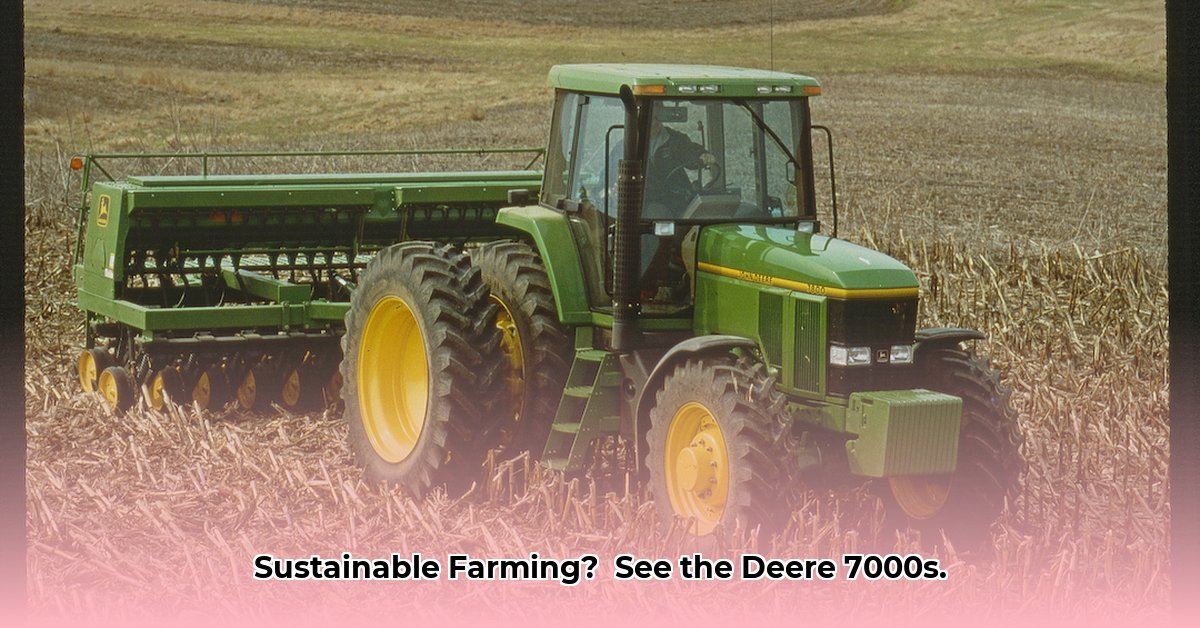
High-Horsepower Tractors and the Sustainability Paradox: A Deep Dive into the John Deere 7000 Series
Big, powerful tractors like the John Deere 7000 series are revolutionizing farming efficiency, allowing farmers to cultivate larger areas and achieve higher yields. But this increased productivity comes with a critical question: at what environmental cost? This article explores the complex interplay between the impressive power of these machines and the drive towards sustainable agriculture, examining both the benefits and the potential drawbacks. We'll delve into the technology, consider the economic implications, and investigate strategies for mitigating environmental impacts. For toy versions of this powerful machine, check out this site.
The John Deere 7000 series boasts significant horsepower, enabling farmers to complete tasks faster and cover more ground. This translates to potential savings in labor costs and increased harvests. However, this efficiency often comes at the expense of increased fuel consumption. But isn't increased fuel consumption inherently unsustainable? How can we reconcile this apparent contradiction?
Fortunately, John Deere has integrated various technologies aimed at mitigating the environmental footprint of these powerful machines. GPS-guided planting optimizes seed placement, minimizing waste and maximizing yields. Variable-rate application of fertilizers and pesticides delivers precisely what's needed, where it's needed, reducing resource consumption and environmental impact. The real-time data analysis capabilities further refine these processes, aiming for optimal efficiency. These advancements are a crucial step toward sustainability. But can they truly offset the inherent drawbacks associated with high horsepower?
Beyond fuel consumption, the sheer weight of these tractors presents another challenge: soil compaction. Compacted soil struggles to retain water and nutrients, impacting long-term soil health and ultimately reducing crop yields. This raises concerns about the long-term viability of relying on these powerful machines for agricultural productivity. Lifecycle assessments are necessary to evaluate the total environmental impact of these tractors from manufacturing to disposal.
The high cost of the 7000 series and its advanced features presents a significant barrier for smaller farms and farmers in developing countries. This raises crucial questions about equitable access to technology. Is a technology truly sustainable if its benefits are largely confined to larger, wealthier operations?
Three Pivotal Points:
- Productivity vs. Sustainability: High-horsepower tractors offer significant gains in productivity but pose environmental challenges due to increased fuel consumption and potential soil compaction.
- Technological Advancements: Features like GPS-guided planting and variable-rate application of inputs strive to mitigate the environmental impact, but their effectiveness is still under scrutiny.
- Equitable Access: The high cost of this technology creates an accessibility gap, potentially hindering the widespread adoption of sustainable farming practices.
Strategies for Sustainable Implementation: Short-Term and Long-Term Approaches
We've identified key challenges. Now, let's examine some actionable steps towards sustainable implementation. These strategies are tailored to various actors involved in the agricultural ecosystem.
1. For Large-Scale Farmers:
- Short-Term: Conduct thorough return-on-investment (ROI) analysis; invest in comprehensive operator training to maximize efficiency and minimize fuel waste.
- Long-Term: Integrate advanced data analytics; explore alternative fuels (biodiesel, hydrogen); actively invest in carbon sequestration practices.
2. For Small-Scale Farmers:
- Short-Term: Explore leasing options; actively seek government subsidies and grants; consider collaborative farming models (cooperatives) to share costs and resources.
- Long-Term: Advocate for policies that support affordable mechanization; participate in collective bargaining and advocacy for equitable access to technology and resources.
3. For Manufacturers (e.g., John Deere):
- Short-Term: Develop more fuel-efficient engines and sustainable manufacturing processes; enhance data platforms to provide farmers with more actionable insights into fuel consumption and environmental impact.
- Long-Term: Invest heavily in R&D of alternative fuels and sustainable materials; conduct rigorous lifecycle assessments for all products, actively seeking ways to reduce environmental impact throughout the entire product lifecycle.
4. For Governments and NGOs:
- Short-Term: Implement policies that incentivize sustainable farming practices; provide farmers with educational resources on environmental stewardship and efficient machinery operation.
- Long-Term: Fund research into sustainable agricultural technologies; promote technology transfer to developing nations; provide financial support and incentives to encourage adoption of sustainable practices.
Mitigating Soil Compaction: A Critical Element of Sustainable Farming
Soil compaction, a significant consequence of heavy machinery, negatively impacts water infiltration, nutrient uptake, and root growth. This can lead to decreased yields and reliance on synthetic fertilizers and irrigation. How can we minimize this impact?
Effective Mitigation Strategies:
Tire Pressure Management: Adjusting tire pressure based on soil conditions is crucial. Lower pressure distributes weight more effectively, reducing compaction.
Wider Tires and Dual Wheels: Increase the contact area, distributing weight more effectively, similar to lower tire pressure.
Rubber Tracks: These offer superior weight distribution, minimizing compaction, especially in wet conditions. However, they represent a higher initial investment.
Controlled Traffic Farming (CTF): Establishing permanent wheel tracks minimizes soil disturbance in the rest of the field. This is a more advanced strategy requiring careful planning but provides significant long-term benefits.
Minimizing Passes: Utilize GPS-guided technology to plan field operations efficiently, reducing the number of times tractors need to travel over the same area.
Optimize Travel Speed: Reduce speed, especially in wet conditions, to lessen impact force on the soil.
Crop Rotation and Cover Crops: These techniques improve soil structure and resilience, making it less susceptible to compaction.
In conclusion, the John Deere 7000 series, while offering significant productivity gains, requires strategic implementation to ensure its role in sustainable agriculture. A balanced approach that considers environmental impacts, economic accessibility, and long-term soil health is crucial. The journey towards truly sustainable farming demands ongoing innovation, collaboration, and a commitment to responsible stewardship of our planet's resources.